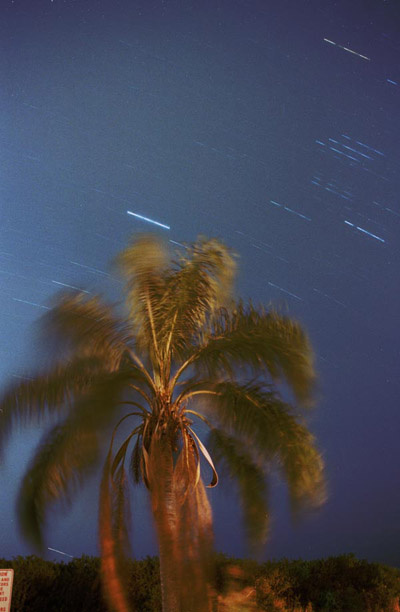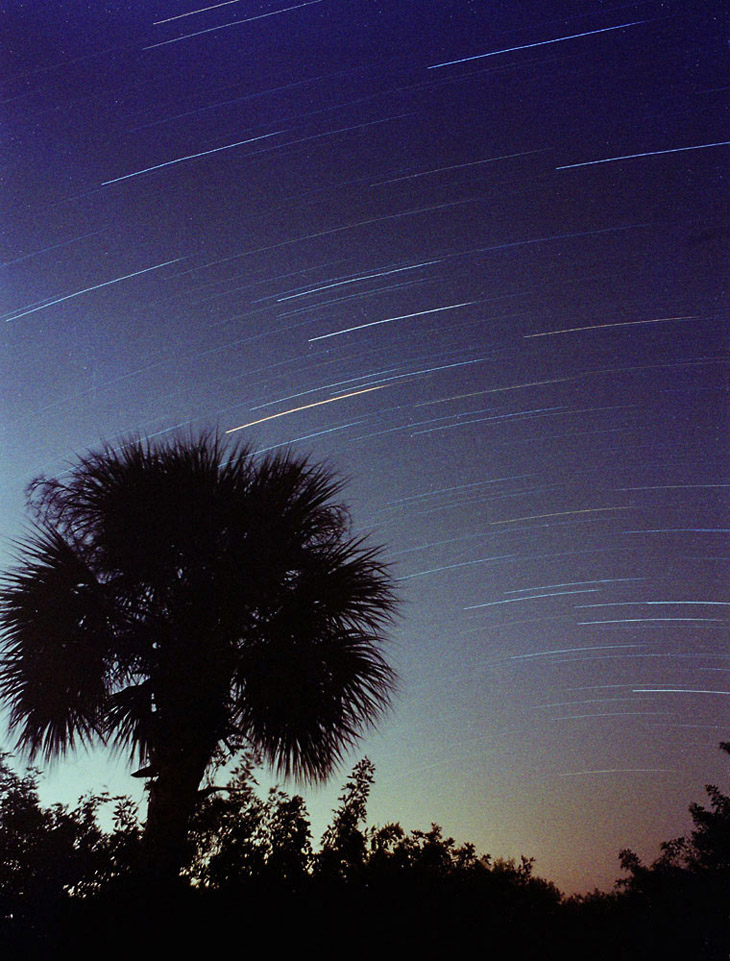
I suddenly realized that the term, “meteorology,” with its inherent inaccuracies, must have come from the predictions for meteor showers, since only once has the claim of a “good storm” come true in my experience. An awful lot of times, when I’ve gone out specifically to view one during peak times, I’ve seen nothing.
With that pessimistic opening, I can say that the Leonids storm is expected to peak Tuesday evening, and the Leonids is the one storm that actually exceeded expectations, once, by a wide margin back in 2001. That one was spectacular, and today’s Astronomy Picture of the Day is a composite image from the same storm. I personally saw two fascinating fireballs that time, breaking up into multiple parts and leaving a trail of bright debris – the kind of display that one cannot actually observe in silence – while my own count of meteors spotted in one night went from the previous record of thirteen to over three hundred.
And yet, I have one meteor captured on film, and that’s not any of the images within this post. Not through lack of trying, either – it’s just that most times the displays have been very weak, with the added factor that the camera is only pointing in one direction so it’s easy enough to be aimed away from the really cool burst. And that night in 2001? The film I had available on short notice was absolute crap for long exposures and produced nothing but grainy blotches. One of the brilliant fireballs might have registered, had I been aimed at it and not at the ‘radiant’ that was supposed to produce most of the activity.
 The radiant is where each of the storms get their names. It is the part of the sky that is facing into the debris that causes a meteor, so the majority will appear to be emanating from that point – in this case, that’s the constellation Leo. One of those bright fireballs, however, appeared close to the horizon and traveled parallel to it, more or less towards the radiant. What’s happening is that meteor storms are bits of junk left in the orbital path of comets, some of the stuff that produces the visible tail as they approach the sun, and each year the Earth encounters this halo of stuff on its own orbit of the sun. The radiant is the point that faces into the wind, as it were, straight off the nose of the Earth – the planet rotates, and with it the sky, but it’s traveling in one particular direction, and in November that’s towards Leo. But as Earth enters this cloud of meteoroids, they may have their own inherent travel directions, not to mention being redirected by the gravitational pull of the planet, so while most of the meteors we might see originate from one direction, they can come from just about anywhere.
The radiant is where each of the storms get their names. It is the part of the sky that is facing into the debris that causes a meteor, so the majority will appear to be emanating from that point – in this case, that’s the constellation Leo. One of those bright fireballs, however, appeared close to the horizon and traveled parallel to it, more or less towards the radiant. What’s happening is that meteor storms are bits of junk left in the orbital path of comets, some of the stuff that produces the visible tail as they approach the sun, and each year the Earth encounters this halo of stuff on its own orbit of the sun. The radiant is the point that faces into the wind, as it were, straight off the nose of the Earth – the planet rotates, and with it the sky, but it’s traveling in one particular direction, and in November that’s towards Leo. But as Earth enters this cloud of meteoroids, they may have their own inherent travel directions, not to mention being redirected by the gravitational pull of the planet, so while most of the meteors we might see originate from one direction, they can come from just about anywhere.
Perhaps the most interesting thing about meteors is their size, which are typically about as small as a grain of sand; the fireballs that we can see sometimes might get as big as a baseball or so. And we’re usually not seeing the meteor itself, but the air around it that gets superheated by the velocity of the meteor.
The streaks in these images are not meteors, but the stars themselves, cruising across the sky as the Earth rotates during the long exposures. In the image here with the palm tree, the gaps in the paths are caused by scattered clouds blowing across the frame, too high to catch any light from the ground and so not actually visible, while the palm tree was illuminated by a distant streetlight and is weaving in the same wind that was driving the clouds, thus the selective blur. While in the image at the top of the post, there is a telltale streak seen at upper right – but it’s not a meteor. It’s actually an Iridium flare, the reflection of the sun from an Iridium communications satellite, typically lasting only a few seconds – I did not know one was scheduled for that evening, and was only doing a star trail exposure over the lake. The glows down on the horizon were expected, being the light from nearby cities, but the blue hazes in the sky are of unknown origin – I’m inclined to say they were because of crappy film (I had been given stacks of old negative film, including several rolls of off-brand stuff, and was blowing off a lot of experiments with it.)
By the way, that photo at top? The foci of all those arcs, the one bright point that isn’t apparently ‘moving,’ is Polaris, the north star. That was intentional, of course.
So if you’re inclined, go out and see what can be spotted, and bear in mind that meteor storms are not limited to the peak evenings, but may have activity before and after peak as well. Not to mention that any night might net you a few, since they can occur at any time – the storms are just known periods of high activity. But dark sky areas, at least, will help you see more, and are almost a necessity for long exposure photography.
A quick note about that photo at APOD, since this is a common thing anymore and it’s more than a little misleading. The Earth is always turning, so the stars are always moving, and long exposures will show this as the streaks seen in the images on this page, unless a tracking apparatus is used to counteract this motion. Even a 30-second exposure can show movement, depending on where the camera is aimed. But if a tracking system is used, then the ground-based details (like the silhouette of the spires in the APOD image) will blur instead, and/or be superimposed in multiple positions in a composite image. So a photo showing a multitude of meteor tracks like that one is, to put it directly, heavily edited, and will not be created “in camera” in any way – there’s a very good chance that the silhouette existed in none of the frames, and was added afterward for interest.
It’s always up to the individual (or an editor) to decide what constitutes ‘acceptable’ digital editing and all that, but the increasing tendencies to use it for astrophotography is at least a bit misleading to those who want to attempt their own shots, or expect to get motionless stars when doing exposures long enough to capture meteors or faint objects. As far as I’m concerned, if you have to composite several frames just to make an interesting image, you might as well throw in a nebula and a starship while you’re at it…





















































